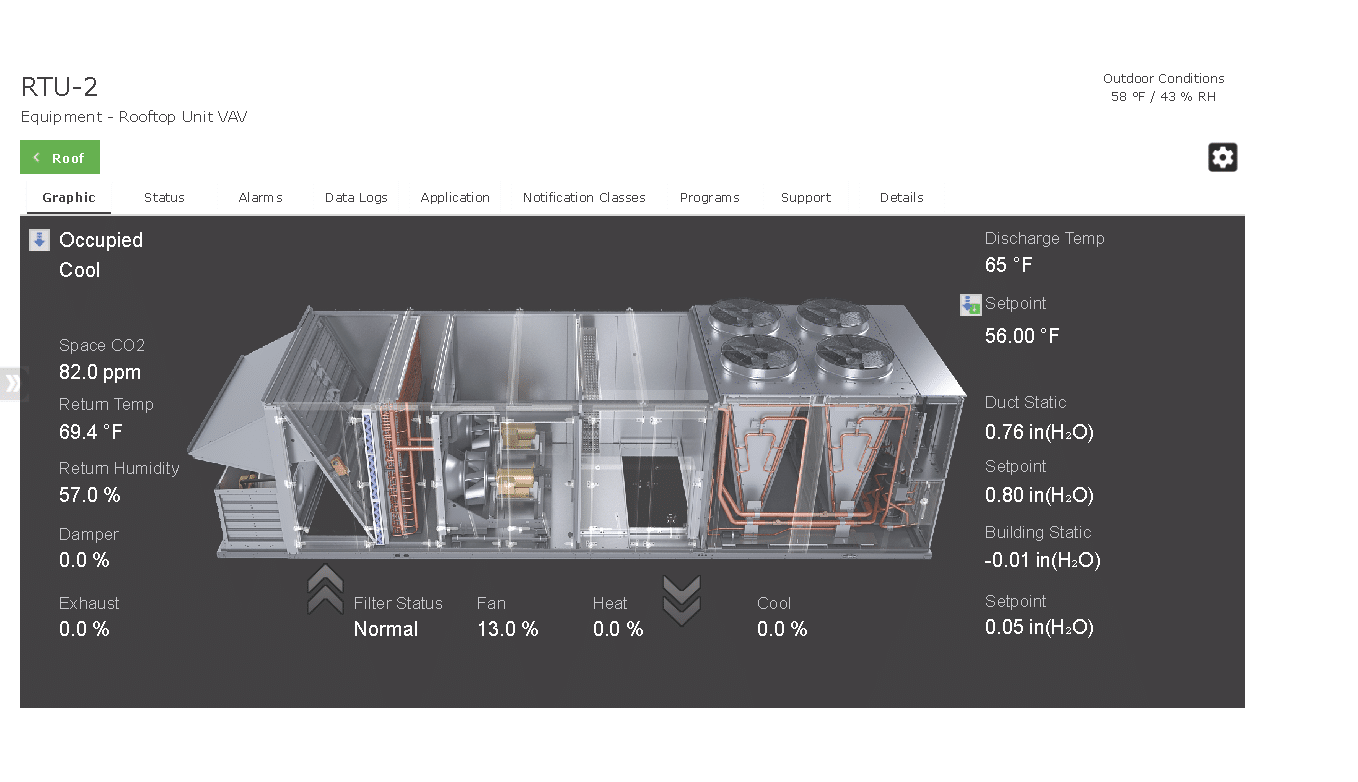Building automation systems (BAS) integrate and control various aspects of a building’s operations, including heating, ventilation, and air conditioning (HVAC), lighting, security, fire and life safety, and energy management. By automating these functions, they help to optimize energy efficiency, improve occupant comfort, and reduce maintenance and operational costs.
Use the links below to jump to each section:
- HVAC Automation
- Lighting Automation
- Security and Access Control
- Fire and Life Safety
- Energy Management
- The Role of Building Engineers in Building Automation Systems
- The Future of Building Automation
HVAC Building Automation Systems
At the heart of any modern commercial building lies the HVAC system, which is responsible for maintaining a comfortable and healthy indoor environment. HVAC building automation systems play a crucial role in ensuring that these systems operate at peak performance while minimizing energy consumption.
Read Next: What Are the Different Types of HVAC Systems for Commercial Buildings?
HVAC automation systems consist of several key components that work together to monitor and control the building’s heating, cooling, and ventilation. These components include:
- Sensors: Temperature, humidity, pressure, and other sensors are strategically placed throughout the building to gather real-time data on indoor conditions.
- Controllers: Direct digital control (DDC) systems, programmable logic controllers (PLCs), and other types of controllers process the data from sensors and make decisions based on programmed algorithms.
- Actuators: Valves, dampers, and other actuators physically adjust the HVAC equipment in response to commands from the controllers.
- Communication Protocols: BACnet, LonWorks, Modbus, and other communication protocols enable the various components of the HVAC automation system to communicate with each other and with other building systems.
The benefits of HVAC automation are numerous. By continuously monitoring and adjusting the system based on actual building conditions, automation can significantly reduce energy consumption and costs. Advanced control strategies, such as demand-controlled ventilation and economizer cycles, further optimize efficiency by delivering the right amount of conditioned air where and when it’s needed.
AQUILA Pro Tip
Advanced control strategies are like smart ways to manage the air conditioning in a building. Two examples of these strategies are:
- Demand-controlled ventilation: This is like having a smart thermostat that can sense how many people are in a room and adjust the air conditioning accordingly. If there are fewer people, it will bring in less fresh air to save energy. If more people enter the room, it will bring in more fresh air to keep everyone comfortable.
- Economizer cycles: This is like having a smart system that can decide whether to use outside air or air conditioning to cool a building. When the weather is nice and cool outside, the system will bring in more outside air to cool the building naturally, without using as much air conditioning. This helps save energy and money.
These advanced control strategies help make the air conditioning system more efficient by providing the right amount of cooled or heated air when and where it’s needed, based on factors like the number of people in a room or the weather outside. This way, the building doesn’t waste energy by cooling or heating empty rooms or using air conditioning when it’s not necessary.
One important aspect of demand-controlled ventilation automation is the management of indoor air quality, particularly the control of carbon dioxide (CO2) levels. High concentrations of CO2 can lead to poor air quality, reduced cognitive function, and other health issues for building occupants.
To address this, modern HVAC automation systems often incorporate CO2 sensors that continuously monitor the concentration of the gas in various zones of the building. When CO2 levels exceed a predetermined threshold, the automation system can take action to increase ventilation rates and bring in more fresh air from outside.
HVAC automation also enhances occupant comfort by maintaining consistent temperature and humidity levels throughout the building. By integrating with other systems, such as lighting and security, HVAC automation can create a more responsive and personalized indoor environment. For example, the system can adjust temperature setpoints based on occupancy patterns or dim the lights when natural daylight is sufficient (we will go more in-depth on lighting automation in the next section).
Read Next: How to Extend the Life of Your Commercial HVAC System
From a maintenance perspective, HVAC automation simplifies system monitoring and troubleshooting. Building engineers can access real-time performance data, receive alerts when issues arise, and make informed decisions about preventive maintenance – all from their phones or laptops. This proactive approach helps to extend equipment life, reduce downtime, and minimize repair costs.
As technology continues to advance, we can expect to see even more sophisticated HVAC automation solutions emerge. Wireless sensors, cloud-based platforms, and machine learning algorithms are just a few of the trends that are shaping the future of building automation.

This screenshot shows the complex system of VAV boxes and fan-powered units that cool or heat a space. Each box can be clicked into and inputs can be adjusted in real time from a laptop.

This screenshot shows a rooftop unit. You can see the readings from sensors that can trigger various automations. For example, the fan will speed up if the temperature rises. The CO2 is also measured here and will automatically be corrected by the system in order to keep tenants comfortable and safe.
Lighting Automation
Lighting is another critical aspect of commercial building operations that can benefit greatly from automation. Lighting control systems use a combination of sensors, controllers, and software to adjust lighting levels based on factors such as occupancy, time of day, and available natural light.
Occupancy sensors detect when a space is being used and turn lights on or off accordingly. According to the U.S. Department of Energy, this simple strategy can reduce lighting energy consumption by 10% to 90% depending on the type of space. Daylight harvesting takes things a step further by dimming or turning off artificial lighting when sufficient natural light is available.
The City of Austin, as part of its Green Building initiative, has implemented requirements for motion sensors in commercial buildings. These requirements are designed to promote energy efficiency and reduce the environmental impact of buildings.
Scheduling and zoning allow building managers to program lighting levels based on typical occupancy patterns and space requirements. For example, common areas may be fully illuminated during business hours, while individual offices can be set to lower levels or turned off entirely when not in use.
Read Next: 34 Commercial Property Management Terms You Should Know (Glossary with Definitions)
Dimming and scene control provide even greater flexibility by allowing users to adjust lighting levels to suit their preferences or the task at hand. In conference rooms and auditoriums, preset lighting scenes can be programmed for different types of events, such as presentations or video conferences.
AQUILA Pro Tip
Scene control, in the context of building automation and lighting systems, refers to the ability to create, save, and recall predefined lighting configurations or “scenes” for a specific space or area. A scene is a combination of settings for multiple lights or light groups, including their brightness levels, color temperatures, and on/off states.
Scene control allows users to quickly and easily change the lighting in a room to suit different activities, moods, or preferences with the touch of a button or through a mobile app.
Like HVAC automation, lighting control systems offer significant energy savings and cost reductions. They also contribute to occupant comfort and productivity by providing the right amount and quality of light for each space and activity. By integrating with other building systems, such as HVAC and security, lighting automation can create a more seamless and responsive indoor environment.
It’s important to note that the effectiveness of these systems depends on proper setup and configuration. The requirements for a warehouse, for example, will be quite different from those for an office building. In a warehouse, motion sensors may need to be more sensitive to detect activity in large, open spaces, while in an office, the focus may be on fine-tuning the system to respond to the presence of individual occupants in smaller rooms.
Security and Access Control
In today’s world, the safety and security of building occupants and assets are paramount. Security and access control systems play a vital role in managing who enters and exits a building, as well as monitoring and responding to potential threats.
Card readers, apps, biometric scanners, and other types of access control devices are used to grant or restrict access to specific areas of a building based on an individual’s credentials. These systems can be programmed to allow different levels of access for different users, such as employees, visitors, or contractors.
Read Next: Cost to Hire a Commercial Property Management Company in Austin, TX (Fees/Rates)
For example, when an employee enters the building after regular business hours, they can swipe their access card at the entrance. The security system recognizes the employee’s credentials and grants them access to the building. Additionally, the system can be integrated with the building’s HVAC and lighting controls to automatically turn on the lights and adjust the temperature in the employee’s office or suite for a predetermined amount of time. This integration provides a seamless and convenient experience for the employee while also ensuring energy efficiency by only activating the necessary systems in the occupied areas. However, it’s important to note that some tenants may opt out of after-hours HVAC services to avoid additional costs.
Other security automation features include video surveillance, intrusion detection, and emergency communication systems. By centralizing and automating these functions, building engineers and managers can respond more quickly and effectively to security incidents, while also reducing labor costs associated with manual monitoring and intervention.
Read Next: 5 Benefits of Using a Property Management Company to Manage Your Office Building
Fire and Life Safety
Fire and life safety systems are essential for protecting building occupants and assets in the event of an emergency. These systems typically include smoke detectors, heat sensors, sprinklers, and other devices that can detect and respond to potential fire or life safety hazards.
When a fire or life safety system detects an incident, it can automatically trigger a series of actions to minimize damage and protect occupants. For example, the system may activate sprinklers or other suppression systems in the affected area, while also sending an alert to building management and emergency responders.
Read Next: An In-Depth Look at Commercial Building Fire Protection Systems
Fire and life safety systems are often integrated with other building systems, such as HVAC and elevators, to provide a more coordinated and effective response. For instance, the HVAC system can be programmed to shut down fans and close dampers to prevent the spread of smoke, while elevators can be automatically recalled to a safe floor to prevent occupants from becoming trapped.
By automating fire and life safety functions, building engineers and managers can ensure a rapid and reliable response to emergencies, even when personnel are not immediately available. This can help to minimize damage, reduce downtime, and most importantly, protect the lives of building occupants.
Energy Management
What is an Energy Management System?
Energy management is a critical concern for commercial building owners and operators, both from a cost and sustainability perspective. Building automation systems (BAS) and energy management systems (EMS) are two essential tools that help address this concern. While BAS and EMS are sometimes integrated into a single, comprehensive system, they can also be implemented as separate, standalone solutions.
Building automation systems (BAS) focus on controlling and automating various building functions, such as heating, ventilation, air conditioning (HVAC), lighting, security, and fire safety. These systems use sensors, controllers, and actuators to monitor and regulate the building’s environment and operations.
Read Next: How to Choose the Right Commercial Property Management Company
On the other hand, energy management systems (EMS) specifically target energy consumption and efficiency. They monitor, analyze, and optimize energy usage across a building’s systems and equipment. When BAS and EMS are integrated, the combined system provides a powerful tool for monitoring and controlling energy consumption in coordination with other building functions.
However, it’s important to note that BAS and EMS can also be implemented separately. In some cases, a building may have a BAS that controls various functions without a dedicated EMS. Alternatively, an EMS can be installed independently to monitor and manage energy consumption, even if a full-scale BAS is not in place.
Regardless of whether BAS and EMS are integrated or separate, both systems play crucial roles in helping commercial building owners and operators manage energy consumption, reduce costs, keep tenants comfortable, and improve sustainability.
How Does an EMS Work?
At the core of an EMS are meters and submeters that track energy usage at the building, system, and equipment levels. This granular data is then fed into specialized software that analyzes patterns, identifies inefficiencies, and recommends optimization strategies.
By integrating with other building automation systems, such as HVAC and lighting, an EMS can dynamically adjust equipment settings and schedules to minimize energy waste while still maintaining occupant comfort. For example, the EMS may automatically adjust HVAC temperature setpoints based on occupancy levels or turn off lights in unoccupied areas.
Download Now: Full Property Inspection Checklist
Advanced EMS software can also provide detailed energy reports, helping building engineers and managers to identify opportunities for further efficiency improvements and to track progress toward sustainability goals. Some systems even offer predictive maintenance capabilities, using machine learning algorithms to detect potential equipment failures before they occur, thus reducing downtime and repair costs.
The benefits of energy management automation are significant. By reducing energy consumption and peak demand, building owners can lower utility bills and minimize their carbon footprint. Automated energy management also helps to ensure compliance with increasingly stringent energy codes and standards, such as LEED.
The Role of Building Engineers in Building Automation Systems
Building engineers play a vital role in the operation, maintenance, and optimization of building automation systems (BAS). As the primary caretakers of these systems, building engineers are responsible for ensuring that the BAS continues to perform optimally, providing a comfortable, safe, and energy-efficient environment for occupants.
Building engineers focus on the day-to-day management and continuous improvement of the BAS. They regularly monitor system performance, analyze data trends, and identify opportunities for optimization. This involves working closely with the BAS software and user interface to review system alarms, adjust setpoints, and modify control sequences as needed to maintain optimal performance.
Building engineers are also responsible for the preventive maintenance of BAS components, such as sensors, controllers, and actuators. They perform regular calibration and testing to ensure that these devices are functioning accurately and reliably. When issues arise, building engineers diagnose and troubleshoot problems, and coordinate repairs or replacements with external vendors or technicians as necessary.
Read Next: Deferred Maintenance in Commercial Property Management: The Snowball Effect
As existing buildings undergo renovations, expansions, or changes in use, building engineers play a key role in adapting the BAS to meet new requirements. They work with contractors and consultants to integrate new equipment or systems into the existing BAS, ensuring compatibility and synergy. Building engineers also update control sequences, setpoints, and schedules to reflect changes in occupancy patterns, space layouts, or energy efficiency targets.
In addition to these technical responsibilities, property managers and building engineers also serve as the primary point of contact for building occupants and stakeholders regarding the BAS. They respond to comfort complaints, explain system features and limitations, and provide training on how to use BAS interfaces or override controls. Building engineers also communicate with upper management or ownership regarding BAS performance, energy consumption, and capital improvement projects.
As technology advances, building engineers must stay up-to-date with the latest BAS software, communication protocols, and analytics tools. They may need to oversee the implementation of system upgrades, such as transitioning from older, proprietary protocols to open standards. Building engineers may also be responsible for implementing fault detection and diagnostics (FDD) tools, which use advanced algorithms to automatically identify and prioritize system issues.
Furthermore, building engineers are increasingly leveraging the data generated by BAS to drive energy efficiency and sustainability initiatives. They use energy management software to track consumption patterns, identify waste, and optimize system performance. Building engineers may also be involved in pursuing green building certifications, such as LEED or ENERGY STAR, which recognize properties that meet specific performance criteria.
The Future of Building Automation
As we’ve seen, building automation systems offer tremendous benefits for commercial properties, from energy efficiency and cost savings to improved occupant comfort and safety. However, to fully realize these benefits, it’s essential that the various systems and components work together seamlessly.
This is where the concepts of system integration and compatibility come into play. By using open communication protocols and standardized data models, building automation systems can share information and coordinate actions across different subsystems and equipment. This level of integration allows for more sophisticated control strategies and more responsive and adaptable building operations.
Looking ahead, the future of building automation is filled with exciting possibilities. The Internet of Things (IoT) is enabling a new generation of smart sensors and devices that can collect and transmit data in real-time, providing even greater insights into building performance. Cloud-based platforms are making it easier to manage and analyze this data, while also enabling remote monitoring and control of building systems.
Read Next: Best Commercial Property Management Firms in Austin, Texas
Artificial intelligence (AI) and machine learning are also poised to revolutionize building automation. By learning from historical data and adapting to changing conditions, AI-powered systems can optimize building performance in ways that were previously impossible. For example, an AI-driven HVAC system could continuously adjust temperature and airflow settings based on real-time occupancy data, weather forecasts, and energy pricing signals.
As these technologies continue to evolve, the role of building engineers will also change. Rather than simply managing individual systems and equipment, building engineers will need to take a more holistic and strategic approach to building operations. They will need to understand how different systems interact and how to leverage data and analytics to drive continuous improvement.
Conclusion
The integration of building automation systems (BAS) has transformed the way commercial buildings are designed, constructed, and operated, enabling unprecedented levels of energy efficiency, occupant comfort, and operational efficiency. However, the success of these systems relies heavily on the expertise of building engineers who design, implement, and maintain them. As the primary interface between the BAS and building occupants, building engineers play a crucial role in ensuring that the systems meet the needs and expectations of those who work in the building.
Building automation systems have the potential to revolutionize the built environment, but this potential can only be fully realized with the support and expertise of building engineers. By investing in the education, training, and professional development of these professionals, we can ensure that our buildings are not only technologically advanced but also human-centered, environmentally responsible, and economically sustainable.
As we move forward, building engineers will be at the forefront of shaping the future of commercial buildings, pushing the boundaries of what is possible with BAS technology and creating a smarter, greener, and more resilient built environment for generations to come.
Are you interested in leveraging building automation systems to enhance your property’s efficiency, comfort, and sustainability? Contact our property management team today to discuss how we can help optimize your building’s performance.












